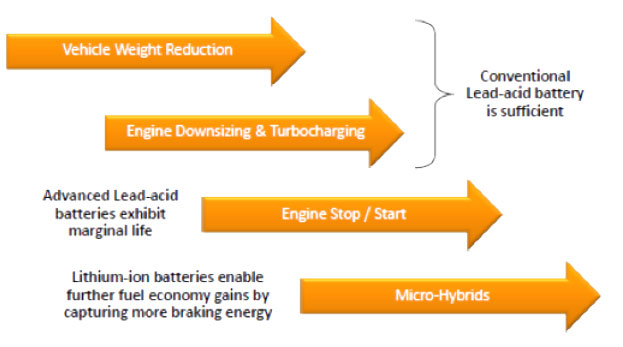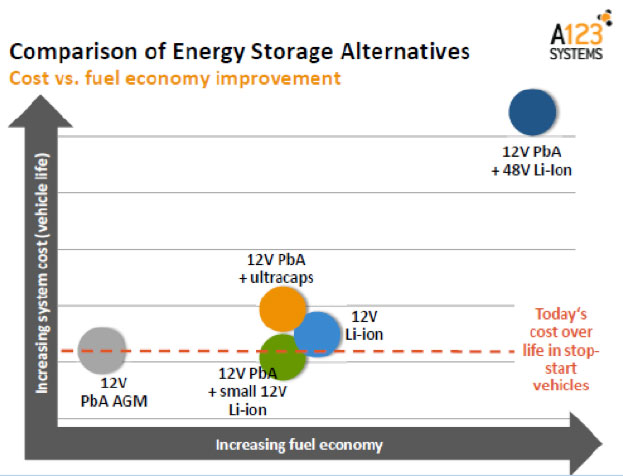
Lithium-Ion Starter Batteries
Since writing the last article on this subject I attended The Battery Technology Show at Novi in Detroit covering the latest technology in the HEV and BEV applications. The need for a much improved charge acceptance for Hybrid drive vehicles, particularly in Europe and North America has led to further development of Lithium-iron Phosphate (LIFePO4) batteries as a viable option for the Idle Stop Start (ISS) rugged duty Internal Combustion Engine (ICE) applications where the traditional lead acid battery tends to fail in charge acceptance capacity.

At the Detroit conference the Lithium battery maker – A123 Systems (new Chinese ownership) launched a newly developed starter battery which went on view to the Conference attendees.
This battery design features an inbuilt Lithium cell Battery Management System (BMS) for each cell load and charge balancing as well as overall battery charge and discharge controls. The battery chemistry chosen is the LiFePO4 which has best stability and control capabilities and is also suitable for the demands of regenerative battery charge when the vehicle is on coast or braking.
The developmental battery size chosen by A123 Systems is the North American type 31 – basically similar to the Australian N70Z design.
The lid or cover is of the raised European DIN design which allows extra space for the inbuilt electronics and for extra cooling capacity. Prototype samples have shown to have a far greater cycle life under the ISS Standard than more conventional lead acid battery chemistry.
Duty cycles of micro-hybrids tend to place quite high regenerative current flows across a receiving battery. Lithium-ion batteries enable further fuel economy gains by capturing more braking energy as can be seen from the chart below.

In designing for maximum charge acceptance the lack of a recovery period requirement between previous charge or discharge cycles and at a significantly higher rate makes the Lithium-ion battery a better overall choice. Weight is around 50% of a typically sized wet or AGM lead acid battery.
The Lithium-ion battery BMS can interface with the vehicle CAN or LIN communication network making reporting of State of Charge (SOC), State of Health (SOH) and State of Function (SOF) data more readily accessible and therefore allows for a total electrical charge regime to be designed into the OE stage of the vehicle. Current “intelligent” power management systems can be eliminated.
Significantly longer life is expected from this new Lithium based chemistry, along with greater useable energy support warranty reduction and consumer total cost of ownership. Lithium-ion batteries like this development will still not come at a low cost. Only time and manufacturing volume acceptance will lower the retail prices to acceptable consumer levels.
The chart below indicates the potential cost savings and fuel economy improvement when comparing traditional battery chemistry with Lithium-ion.

Chart courtesy A123 Systems

The next development will probably be the use of a Lithium-ion battery in conjunction with a SuperCap for start operation and a 48 volt system.
Bob Gell and his business GELCOservices operates a Technical Laboratory service and Consultancy based in Adelaide which focusses on battery testing and validation to manufacturer’s specifications and relevant Standards. More info go to www.gelcoservices.com.au



